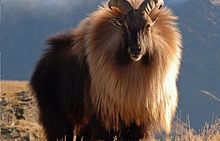
Tahrs are large artiodactyl ungulates related to goats and sheep. There are three species, all native to Asia. Previously thought to be closely related to each other and placed in a single genus, Hemitragus, genetic studies have since proven that they are not so closely related and they are now considered as members of three separate monotypic genera: Hemitragus is now reserved for the Himalayan tahr, Nilgiritragus for the Nilgiri tahr, and Arabitragus for the Arabian tahr.

The Himalayan tahr is a large even-toed ungulate native to the Himalayas in southern Tibet, northern India, western Bhutan and Nepal. It is listed as Near Threatened on the IUCN Red List, as the population is declining due to hunting and habitat loss.

The subfamily Caprinae is part of the ruminant family Bovidae, and consists of mostly medium-sized bovids. A member of this subfamily is called a caprine, or, more informally, a goat-antelope.

The Bovidae comprise the biological family of cloven-hoofed, ruminant mammals that includes cattle, bison, buffalo, antelopes, and goat-antelopes. A member of this family is called a bovid. With 143 extant species and 300 known extinct species, the family Bovidae consists of eight major subfamilies apart from the disputed Peleinae and Pantholopinae. The family evolved 20 million years ago, in the early Miocene.

The four-horned antelope, or chousingha, is a small antelope found in India and Nepal. Its four horns distinguish it from most other bovids, which have two horns. The sole member of the genus Tetracerus, the species was first described by French zoologist Henri Marie Ducrotay de Blainville in 1816. Three subspecies are recognised. The four-horned antelope stands nearly 55–
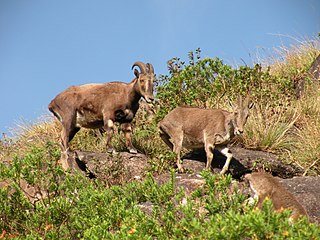
The Nilgiri tahr is an ungulate that is endemic to the Nilgiri Hills and the southern portion of the Western and Eastern Ghats in the states of Tamil Nadu and Kerala in southern India. It is the state animal of Tamil Nadu. Despite its local name, it is more closely related to the sheep of the genus Ovis than the ibex and wild goats of the genus Capra.

Budorcas is a genus of bovid that contains a single living species, the takin (Budorcas taxicolor). Two extinct species are known from the Pliocene, B. teilhardi from China and B churcheri from Ethiopia. The presence of the genus in Africa indicates that it was far more widespread in the past.
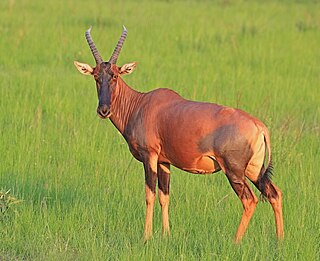
Damaliscus, commonly known as tsessebes, is a genus of antelope in the family Bovidae, subfamily Alcelaphinae, found in Africa.

The Arabian tahr is a species of tahr native to eastern Arabia. Until recently, it was placed in the genus Hemitragus, but genetic evidence supports its removal to a separate monotypic genus.

The Caninae, known as canines, are one of three subfamilies found within the canid family. The other two canid subfamilies are the extinct Borophaginae and Hesperocyoninae. The Caninae includes all living canids and their most recent fossil relatives. Their fossils were first found in North America and dated to the Oligocene era, then spreading to Asia at the end of the Miocene era, some 7 million to 8 million years ago.

The tribe Bovini, or wild cattle are medium to massive bovines that are native to North America, Eurasia, and Africa. These include the enigmatic, antelope-like saola, the African and Asiatic buffalos, and a clade that consists of bison and the wild cattle of the genus Bos. Not only are they the largest members of the subfamily Bovinae, they are the largest species of their family Bovidae. The largest species is the gaur, weighing up to 1,500 kg (3,300 lb).

The tribe Tragelaphini, or the spiral-horned antelopes, are bovines that are endemic to sub-Sahara Africa. These include the bushbuck, kudus, and the elands. The scientific name is in reference to the mythical creature the tragelaph, a Chimera with the body of a stag and the head of a goat. They are medium-to-large, tall, long-legged antelopes characterized by their iconic twisted horns and striking pelage coloration patterns.

Bootherium is an extinct bovid genus from the middle to late Pleistocene of North America which contains a single species, Bootherium bombifrons. Vernacular names for Bootherium include Harlan's muskox, woodox, woodland muskox, helmeted muskox, or bonnet-headed muskox. Bootherium was one of the most widely distributed muskox species in North America during the Pleistocene era. It is most closely related to the modern muskox, from which it diverged around 3 million years ago, it is possibly synonymous with Euceratherium, although this is uncertain.

Soergelia is a genus of extinct ovibovine caprine that was common across Europe, North America and Asia in the Pleistocene epoch.

Hemibos is an extinct even-toed ungulate belonging to the family Bovidae. Its fossil remains were found across Asia and Europe such as from China, Italian Peninsula, Iberian Peninsula, and State of Palestine, Israel, Pakistan, India.
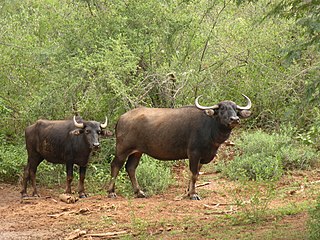
Bubalina is a subtribe of wild cattle that includes the various species of truebuffalo. Species include the African buffalo, the anoas, and the wild water buffalo. Currently, buffalos can be found naturally in sub-Saharan Africa, South Asia and Southeast Asia, and domestic and feral populations have been introduced to Europe, the Americas, and Australia. In addition to the living species, bubalinans have an extensive fossil record where remains have been found in much of Afro-Eurasia.
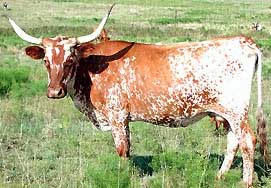
Bovina is a subtribe of the Bovini tribe that generally includes the two living genera, Bison and Bos. However, this dichotomy has been challenged recently by molecular work that suggests that Bison should be regarded as a junior synonym of Bos. Wild bovians can be found naturally in North America and Eurasia.
Hemitragus cedrensis is an extinct species of bovid known from the Eemian of France and the Iberian peninsula.
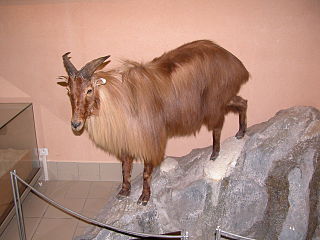
Hemitragus bonali, the Bonal tahr, is an extinct species of bovid from the Pleistocene of Europe and the Caucasus mountains region.
Budorcas churcheri is an extinct species of takin that lived in the Pliocene of Ethiopia. Its remains were found in the Hadar Formation.
